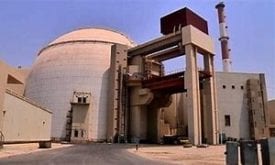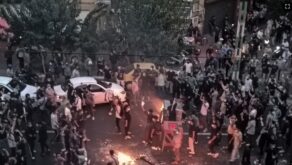CHRI – Protests erupted in several Iranian cities on December 28, 2017, as citizens peacefully spoke out against the rising cost of living. In Mashhad, Iran’s second most populated city, police confronted the demonstrators with water cannons and tear gas.
An eyewitness in Neishabour told the Center for Human Rights in Iran (CHRI) that the protests against the perception of rising inflation were organized via announcements shared on social media.
“I don’t know who the main organizer was but the announcements started appearing last night [December 27] on Telegram network channels related to Neishabour,” said the eyewitness, who requested anonymity for security reasons.
“In the beginning, the protests were peaceful and the slogans were about high prices and economic corruption,” added the source. “But towards the end, baton-wielding police attacked the crowd from both sides of the street and arrested some people.”
“They chased us but we were able to get away,” added the source.
Iran’s inflation rate was recorded at 9.9 percent in December 2017, according to the International Monetary Fund (IMF). It was as high as 35 percent during President Hassan Rouhani’s first year in office in 2013.
Images sent to CHRI and postings on social media show people in other cities in Khorasan Razavi Province, including Neishabour and Kashmar, shouting slogans including, “death to high prices,” “death to the dictator,” and “Death to Rouhani.”
Some demonstrators also called for an end to Iran’s involvement in the Syrian civil war, where it backs President Bashar al-Assad, as well as for the state to stop using public funds to support Shi’ites in Lebanon and Palestinians against the Israeli occupation.
The protests in Mashhad, which were attended by hundreds according to footage posted on social media and sent to CHRI, ended after about two hours after police intervened and arrested several participants.
Mashhad’s Governor Mohammad Rahim Norouzian condemned the protesters for what he referred to as their “illegal” demonstration while praising the police for “showing extreme restraint” and arresting people “who wanted to destroy public property.”
According to Article 27 of Iran’s Constitution, “Public gatherings and marches may be freely held, provided arms are not carried and that they are not detrimental to the fundamental principles of Islam.”
According to CHRI’s investigations, social media users discussed the protests using the Farsi-language hashtag, “Mashhad.” Iranians based out of Tehran, Khorasan Razavi, Khuzestan, Fars and Isfahan provinces tweeted more than 11,000 times since the protests began on December 27.
Reformist member of Parliament Mahmoud Sadeghi tweeted his support for the people: “The people’s protests in Mashhad and other cities are in fact an outcry against the confusion and shortcomings that exist in the top layers of the country. Instead of extinguishing the protests and blaming them on political factions, we should listen to the people and find solutions.”
Prior to the latest unrest, there had been small but almost daily protests in numerous cities by people who have lost their life savings due to private banks and investment companies going bankrupt.
On December 27, Supreme Leader Ali Khamenei criticized the “baseless statistics, lies, and slander … against the achievements of the Islamic Revolution” and blamed the state’s foreign “enemies.”
“Unfortunately, some unscrupulous people in the country are making accusations against officials and organizations in an effort to justify the unbelievable lies spread by the enemies,” he said.
“Those in charge of the country, past and present, cannot play the role of the opposition and speak against the state,” he added.
 Shabtabnews In this dark night, I have lost my way – Arise from a corner, oh you the star of guidance.
Shabtabnews In this dark night, I have lost my way – Arise from a corner, oh you the star of guidance.


